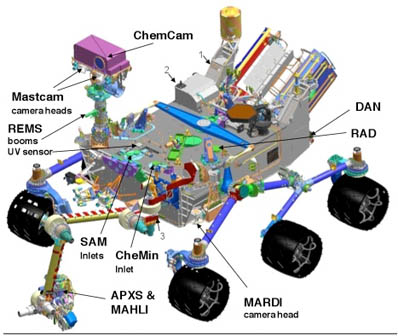
Mars-bound rover previewing the experience for astronauts
JUSTIN RAY
SPACEFLIGHT NOW
Posted: 15 December 2011


Already 32 million miles from Earth on its interplanetary trek to Mars, the Curiosity rover has begun collecting useful scientific data about the radiation conditions that astronauts would encounter on the way to the red planet.

This is an artist's concept of NASA's Mars Science Laboratory spacecraft during its cruise. The spacecraft includes a disc-shaped cruise stage (on the left) attached to the aeroshell that contains the rover and descent stage. Credit: NASA/JPL-Caltech
|
The Radiation Assessment Detector, an instrument mounted the rover, has begun obtaining measurements on energetic particles penetrating the Mars Science Laboratory spacecraft.
"RAD is serving as a proxy for an astronaut inside a spacecraft on the
way to Mars," said Don Hassler, RAD's principal investigator from the
Southwest Research Institute in Boulder, Colo. "The instrument is deep
inside the spacecraft, the way an astronaut would be. Understanding
the effects of the spacecraft on the radiation field will be valuable
in designing craft for astronauts to travel to Mars."
The device, about the size of a coffee can and weighing 3.8 pounds, was powered up and started gathering data on Dec. 6, some two weeks ahead of schedule. It will downlink data every 24 hours.
"The first data packets from RAD look great," Hassler said. "We are seeing a
strong flux in space, even inside the spacecraft, about four times
higher doses of radiation than the baseline we measured on the launch
pad from the RTG, or radioisotope thermoelectric generator, used to
power the rover. It's very exciting to begin the science mission."

The location of RAD is illustrated in this artwork. Credit: NASA/JPL-Caltech
|
Curiosity is folded up and packaged inside the descent capsule that will plunge into the Martian atmosphere the night of August 5 (U.S. time), protected by a heat shield and equipped with a large parachute. A rocket-powered sky crane will then carefully lower the car-sized rover onto the planet's surface to begin a two-year mission of studying Gale Crater and whether the area was once hospitable to life.
The radiation detector will continue operating on Mars to show what astronauts working on the planet would experience.
"RAD was designed for the science mission to characterize radiation
levels on the surface of Mars, but an important secondary objective is
measuring the radiation on the almost nine-month journey through
interplanetary space, to prepare for future human exploration," said
Hassler. "RAD is an important bridge between the science and
exploration sides of NASA."
| |

The Radiation Assessment Detector. Credit: Southwest Research Institute
|
The energetic particle originate from galactic cosmic rays, distant supernovas and coronal mass ejections from the Sun that launch clouds of radiation streaming across the solar system.
"Not only will this give us insight into the physics of these giant
clouds, but as particles from these clouds hit the spacecraft, an
inward cascade of secondary particles is released inside the capsule,
which could pose a potentially greater biological hazard," said
Hassler. "Like an astronaut, RAD is tucked inside the spacecraft for
the journey and will characterize these secondary particle showers.
RAD also measures the higher energy galactic cosmic rays and the
secondary particles that they produce inside the spacecraft."
RAD was built by Southwest Research Institute and the Christian Albrechts University in Kiel, Germany, using funding from NASA's Human Exploration and Operations Mission Directorate and Germany's national aerospace research center.
|



